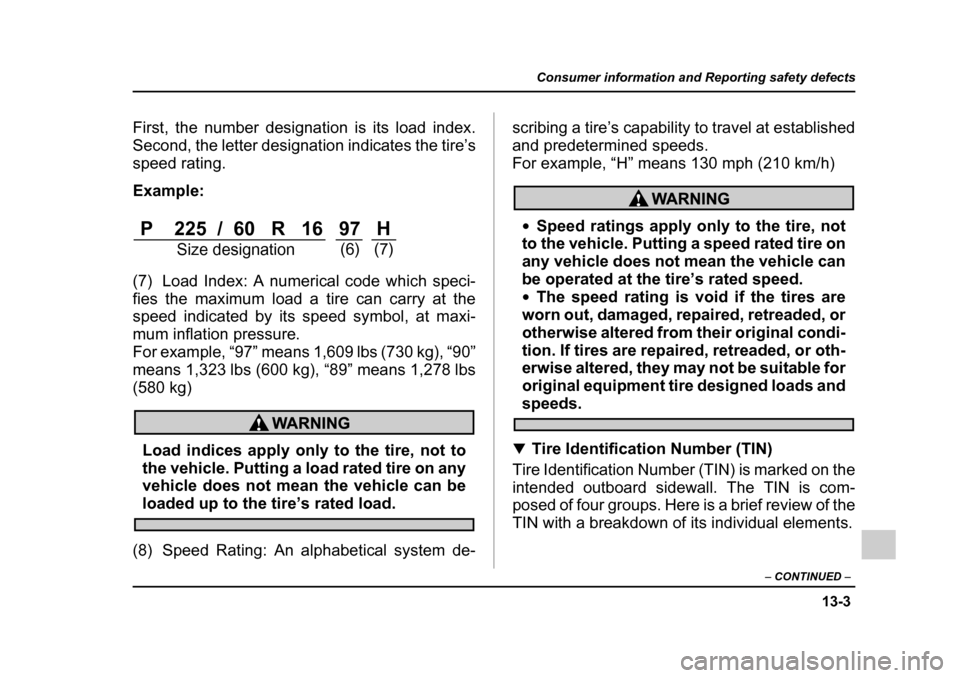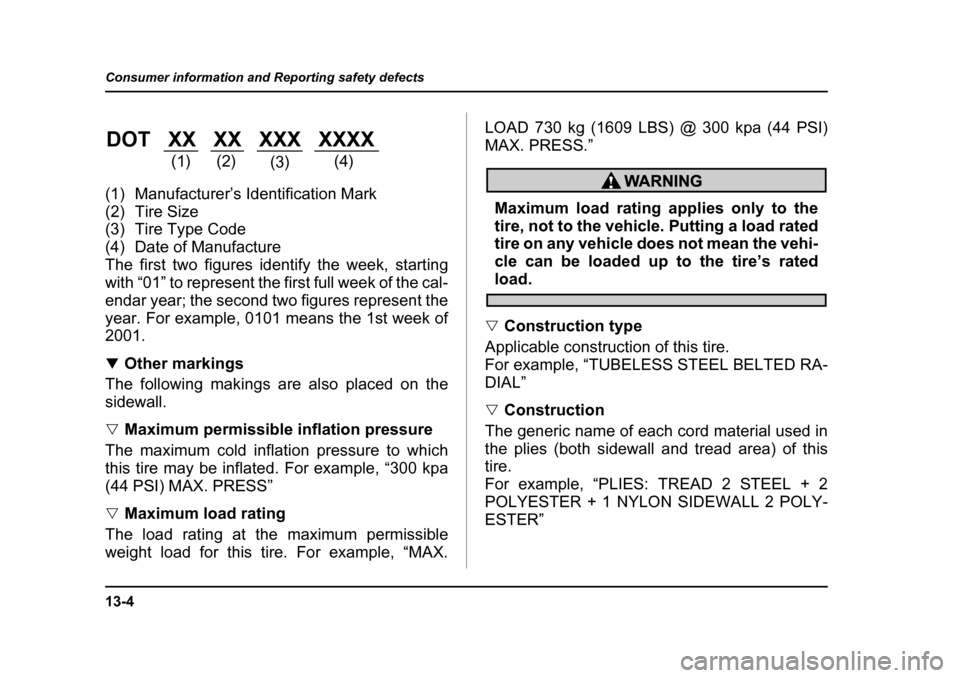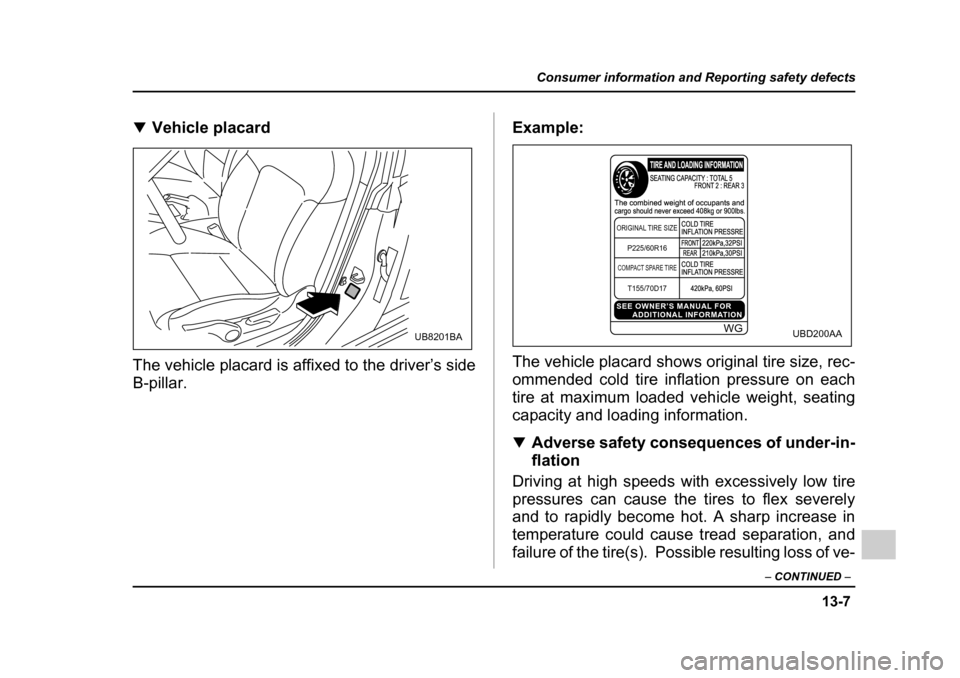tire pressure SUBARU OUTBACK 2005 4.G Owner's Guide
[x] Cancel search | Manufacturer: SUBARU, Model Year: 2005, Model line: OUTBACK, Model: SUBARU OUTBACK 2005 4.GPages: 627, PDF Size: 6.42 MB
Page 600 of 627

13-3
Consumer information and Reporting safety defects
– CONTINUED –
First, the number designation is its load index.
Second, the letter designation indicates the tire’s
speed rating.
Example:
(7) Load Index: A numerical code which speci-
fies the maximum load a tire can carry at the
speed indicated by its speed symbol, at maxi-
mum inflation pressure.
For example, “97” means 1,609 lbs (730 kg), “90”
means 1,323 lbs (600 kg), “89” means 1,278 lbs (580 kg)
Load indices apply only to the tire, not to
the vehicle. Putting a load rated tire on any
vehicle does not mean the vehicle can be
loaded up to the tire’s rated load.
(8) Speed Rating: An alphabetical system de- scribing a tire’s capability to travel at established
and predetermined speeds.
For example, “H” means 130 mph (210 km/h)
"
Speed ratings apply only to the tire, not
to the vehicle. Putting a speed rated tire on
any vehicle does not mean the vehicle can
be operated at the tire’s rated speed. " The speed rating is void if the tires are
worn out, damaged, repaired, retreaded, or
otherwise altered from their original condi-
tion. If tires are repaired, retreaded, or oth-
erwise altered, they may not be suitable for
original equipment tire designed loads and
speeds.
! Tire Identification Number (TIN)
Tire Identification Number (TIN) is marked on the
intended outboard sidewall. The TIN is com-
posed of four groups. Here is a brief review of the
TIN with a breakdown of its individual elements.
P 225 / 60 R 16 97 H Size designation (6) (7)
Page 601 of 627

13-4
Consumer information and Reporting safety defects
(1) Manufacturer’s Identification Mark
(2) Tire Size
(3) Tire Type Code
(4) Date of Manufacture
The first two figures identify the week, starting
with “01” to represent the first full week of the cal-
endar year; the second two figures represent the
year. For example, 0101 means the 1st week of
2001. !
Other markings
The following makings are also placed on the
sidewall. " Maximum permissible inflation pressure
The maximum cold inflation pressure to which
this tire may be inflated. For example, “300 kpa
(44 PSI) MAX. PRESS” " Maximum load rating
The load rating at the maximum permissible
weight load for this tire. For example, “MAX. LOAD 730 kg (1609 LBS) @ 300 kpa (44 PSI)
MAX. PRESS.”Maximum load rating applies only to the
tire, not to the vehicle. Putting a load rated
tire on any vehicle does not mean the vehi-
cle can be loaded up to the tire’s rated
load.
" Construction type
Applicable construction of this tire.
For example, “TUBELESS STEEL BELTED RA-
DIAL” " Construction
The generic name of each cord material used in
the plies (both sidewall and tread area) of this
tire.
For example, “PLIES: TREAD 2 STEEL + 2
POLYESTER + 1 NYLON SIDEWALL 2 POLY-
ESTER”
DOT XX XX XXX XXXX (1) (2) (3)(4)
Page 603 of 627

13-6
Consumer information and Reporting safety defects !
Recommended tire inflation pressure
! Recommended cold tire inflation pressure
Recommended cold tire inflation pressure for your vehicle’s tires is as follows,
Tire size P205/55R16 89H215/45ZR17 P225/60R16
97HP225/55R17
95V
Wheel size 16 x 6.5JJ 17 x 7JJ 16 x 6.5JJ 17 x 7JJ
Pressure Front 32 psi (220 kPa, 2.2 kgf/cm2
) 35 psi (240 kPa,
2.4 kgf/cm 2
) 32 psi (220 kPa, 2.2 kgf/cm
2
)
Rear 30 psi (210 kPa, 2.1 kgf/cm2
) 33 psi (230 kPa,
2.3 kgf/cm 2
) 30 psi (210 kPa, 2.1 kgf/cm
2
)
Rear at trailer towing – 32 psi (220 kPa, 2.2 kgf/cm
2
)
Tempo-
rary spare tire Size T135/80R16 T135/70D17 T155/70D17
Pressure 60 psi (420 kPa, 4.2 kgf/cm
2
)
Page 604 of 627

13-7
Consumer information and Reporting safety defects
– CONTINUED –
!Vehicle placard
The vehicle placard is affixed to the driver’s side
B-pillar. Example:
The vehicle placard shows original tire size, rec-
ommended cold tire inflation pressure on each
tire at maximum loaded vehicle weight, seating
capacity and loading information. !
Adverse safety consequences of under-in-
flation
Driving at high speeds with excessively low tire
pressures can cause the tires to flex severely
and to rapidly become hot. A sharp increase in
temperature could cause tread separation, and
failure of the tire(s). Possible resulting loss of ve-
UB8201BAWG
TIRE AND LOADING INFORMATIONSEATING CAPACITY : TOTAL 5
ORIGINAL TIRE SIZE
SEE OWNER’S MANUAL FOR
ADDITIONAL INFORMATION
COLD TIRE
INFLATION PRESSRE
COLD TIRE
INFLATION PRESSRE
FRONT
REAR220kPa,32PSI 210kPa,30PSIP225/60R16
T155/70D17
420kPa, 60PSI
COMPACT SPARE TIRE
The combined weight of occupants andcargo should never exceed 408kg or 900lbs.
FRONT 2 : REAR 3
UBD200AA
Page 605 of 627

13-8
Consumer information and Reporting safety defects
hicle control could lead to an accident. !
Measuring and adjusting air pressure to
achieve proper inflation
Check and, if necessary, adjust the pressure of
each tire (including the spare) at least once a
month and before any long journey. Check the
tire pressures when the tires are cold. Use a
pressure gauge to adjust the tire pressures to the
specific values. Driving even a short distance
warms up the tires and increases the tire pres-
sures. Also, the tire pressures are affected by the
outside temperature. It is best to check tire pres-
sure outdoors before driving the vehicle. When a
tire becomes warm, the air inside it expands,
causing the tire pressure to increase. Be careful
not to mistakenly release air from a warm tire to
reduce its pressure. ! Glossary of tire terminology
" Cold tire pressure
The pressure in a tire that has been driven less
than 1 mile or has been standing for three hours
or more. " Maximum inflation pressure The maximum cold inflation pressure to which a
tire may be inflated. "
Recommended inflation pressure
The cold inflation pressure recommended by a
vehicle manufacturer. " Intended outboard sidewall
1)The sidewall that contains a whitewall, bears
white lettering or bears manufacturer, brand,
and/or model name molding that is higher or
deeper than the same molding on the other
sidewall of the tire, or
2)The outward facing sidewall of an asymmet-
rical tire that has a particular side that must al-
ways face outward when mounting on a vehi-
cle.
" Accessory weight
The combined weight (in excess of those stan-
dard items which may be replaced) of floor mats,
leather seats and cross bars to the extent that
these items are available as factory-installed
equipment (whether installed or not). " Curb weight
The weight of a motor vehicle with standard
equipment including the maximum capacity of fu-
el, oil, and coolant and air conditioning.
Page 624 of 627

14-9
Index
Tilt steering wheel ............................................. 3-63 Tire
Chains .......................................................... 8-17
Inspection ................................................... 11-51
Pressures and wear .................................... 11-52
Replacement .............................................. 11-56
Rotation ...................................................... 11-55
Tires .................................................................. 12-5
Types .......................................................... 11-49
Tires and wheels ............................................. 11-49
Top tether anchorages ...................................... 1-55
Towing ............................................................... 9-21 All wheels on the ground .............................. 9-28
Flat-bed truck ................................................ 9-27
Tie-down hooks ............................................ 9-22
Weight .......................................................... 8-31
Trailer
Hitch ............................................................. 8-27
Hitches .......................................................... 8-37
Towing .......................................................... 8-31
Towing tips ................................................... 8-40
Trip meter ................................................. 3-10, 3-16
Trunk lid ............................................................. 2-35
Release handle ............................................. 2-37
Trunk light ........................................................ 11-86
Turn signal
Indicator lights .............................................. 3-34 Lever ............................................................. 3-47
U
Under-floor storage compartment ..................... 6-30 V
Valet mode ........................................................ 2-27
Vanity mirror ........................................................ 6-6
Vehicle Capacity weight ............................................ 8-19
Identification ............................................... 12-11
Vehicle Dynamics Control
OFF indicator light ........................................ 3-32
OFF switch ................................................... 7-48
Operation indicator light ................................ 3-31
System .......................................................... 7-43
Warning light ................................................. 3-32
Ventilator ............................................................. 4-2 W
Warning and indicator lights .............................. 3-20
Warning lights ABS .............................................................. 3-28
All-wheel drive .............................................. 3-31
Anti-lock Brake system ................................. 3-28
AT OIL TEMPerature .................................... 3-27
Page 627 of 627

GAS STATION REFERENCE
Fuel: !2.5-liter non-turbo models
Use only unleaded gasoline with an octane rating of
87 AKI or higher. ! 2.5-liter turbo models and 3.0-liter models
Use premium unleaded gasoline with an octane rat-
ing of 91 AKI or higher. For temporary purposes if
premium unleaded gasoline is not available, you
may use regular unleaded gasoline with an octane
rating of 87 AKI or higher. For optimum engine per-
formance and driveability, it is required (for 2.5-liter
turbo models), and recommended (for 3.0-liter mod-
els) that you use premium grade unleaded gasoline. ! Fuel octane rating
This octane rating is the average of the Research Octane and Motor Octane numbers and is commonly
referred to as the Anti Knock Index (AKI). Refer to
“Fuel” section in this manual.
Fuel capacity:
16.9 US gal (64 liters, 14.1 Imp gal) Engine oil:
Use only API classification SL with the words “EN-
ERGY CONSERVING” and the New API certification
mark (starburst mark) displayed on the container. Engine oil capacity:
2.5-liter models: 4.2 US qt (4.0 liters, 3.5 Imp qt)
3.0-liter models: 5.8 US qt (5.5 liters, 4.8 Imp qt)
Cold tire pressure: Tire size P205/55R16 89H 215/45ZR17 P225/60R16 97H P225/55R17 95V
Wheel size 16 x 6.5JJ 17 x 7JJ 16 x 6.5JJ 17 x 7JJ
Pressure Front 32 psi (220 kPa, 2.2 kgf/cm2
) 35 psi
(240 kPa, 2.4 kgf/cm 2
) 32 psi (220 kPa, 2.2 kgf/cm
2
)
Rear 30 psi (210 kPa, 2.1 kgf/cm 2
) 33 psi
(230 kPa, 2.3 kgf/cm 2
) 30 psi (210 kPa, 2.1 kgf/cm
2
)
Rear at trail-
er towing – 32 psi (220 kPa, 2.2 kgf/cm
2
)
Temporary
spare tire Size T135/80D16 T135/70D17 T155/70D17
Pressure
60 psi (420 kPa, 4.2 kgf/cm2
)